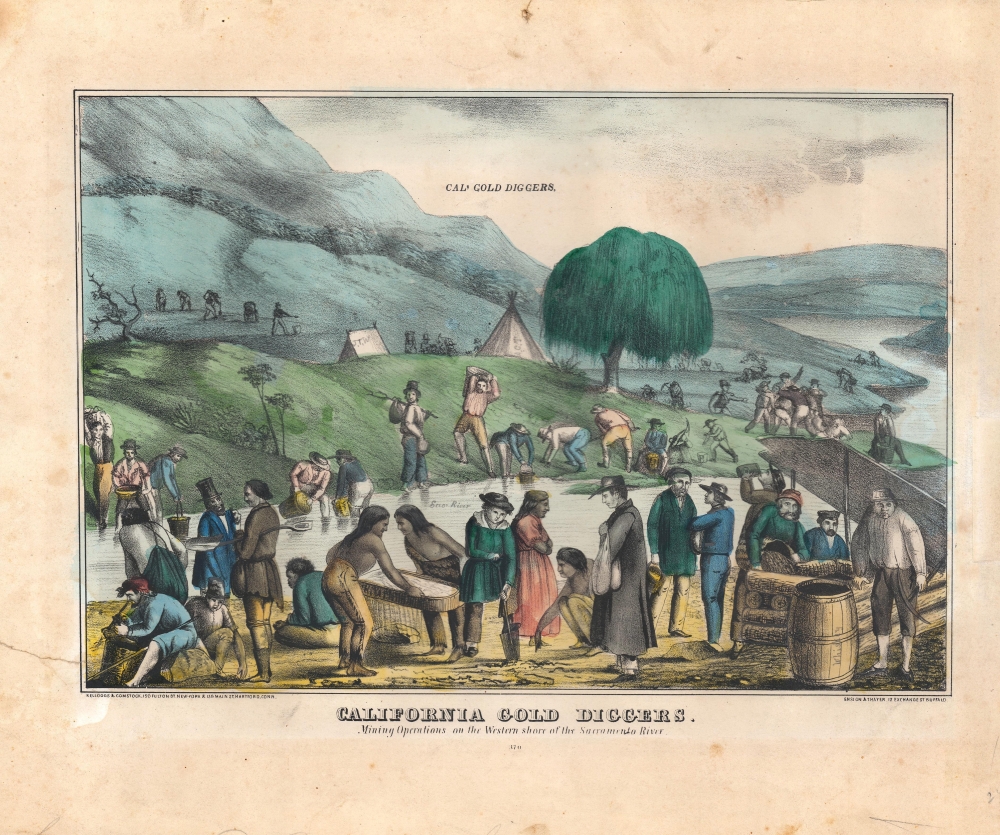This item has been sold, but you can get on the Waitlist to be notified if another example becomes available, or purchase a digital scan.
1849 View of California Gold Rush, Sacramento River
CAGoldDiggers-kellogg-1849
Title
1849 (undated) 8.5 x 12.5 in (21.59 x 31.75 cm)
Description
A Closer Look
This hand-colored view portrays the California Gold Rush in its earliest stage, and much like its subject matter the print itself has a somewhat inchoate quality. Faint notes appear almost like pencil, for example adding abbreviations to tents and clarifying that a barrel in the foreground at right is full of whiskey. Some of the figures depicted remain uncolored or only partially colored.Perhaps the most notable feature of the individuals illustrated is their diversity. Native Americans pan for gold and direct a White prospector on where to dig in the foreground, while what appear to be two Black men appear at left, facing away from the viewer (it was not uncommon for prospectors from the Southern U.S. to bring slaves with them to hunt for gold).
The rough-and-tumble nature of the Gold Rush is suggested by the aforementioned barrel of whiskey and a group of men brawling in the background at right, while a uniformed authority figure futilely attempts to break them up. Several of the figures look to have a haggard or even ghastly pallor, signifying that prospecting was not all gold and glory. The print is also significant for highlighting the various methods and technologies employed by prospectors in the hunt for gold.
Publication History and Census
This view was prepared by 'Kelloggs and Comstock' and printed by Ensign and Thayer. Though undated, both the details present in the print and the use of the title 'Ensign and Thayer' (as opposed to the later 'Ensign, Thayer, and Co.' or several other names) suggest a date of 1849. The number '370' in the bottom margin may indicate that it was part of a larger publication, but if so, the original publication has been lost in the cartobibliographic record. There are two known printings of this view, one by D. Needham and the present one, by Ensign and Thayer. In either event, the view is quite rare, only being noted among the institutional holdings of the American Antiquarian Society, Yale University (Beinecke), and the University of California Berkeley (Bancroft).CartographerS
Edmund Burke Kellogg (May 27, 1809 - March 26, 1872) was an American lithographer and printer. Born in Tolland, Connecticut, Kellogg trained as a newspaper printer and was apprenticed with Samuel Green in New London, Connecticut. Kellogg joined his probers Daniel Wright Kellogg (1807 - 1874) and Elijah Chapman Kellogg (1811 - 1881) at Daniel's firm D.W. Kellogg and Company sometime in the 1830s. Around 1836, Daniel moved west, and Edmund and Elijah took over the firm. Edmund and Elijah renamed the firm E.B. and E.C. Kellogg in 1842. This firm operated until 1848, when John C. Comstock joined the brothers and the business became Kellogg and Comstock. The partnership with Comstock lasted only until 1850, and the brothers went their separate ways. Edmund and Elijah reopened E.B. and E.C. Kellogg in 1855. Elijah's son, Charles B. Kellogg, joined the firm around 1865. Edmund and Elijah sold their interest in the firm to William H. Bulkeley (1840 - 1902) in 1867. The younger Kellogg and Bulkeley partnered to form the firm Kellogg and Bulkeley. Kellogg and Bulkeley operated until 1946, when it merged with Case, Lockwood, and Brainard to form Connecticut Printers, Inc, which is still in operation today. More by this mapmaker...
Edward Hooker Ensign (August 18, 1818 - July 10, 1871) was an American map and print publisher based in New York during the middle part of the 19th century. Edward was born in West Hartland, Connecticut. Little is known of Ensign's training but he may have inherited his business from his father, Timothy Ensign (1795 - 1859), who was a map publisher active in New York. Ensign seems to have had a flair for partnerships and variously published with Humphrey Phelps (1799 - 1875), Horace Thayer, Thomas C. Fanning (1805 - 1873) and Erastus C. Bridgman (1817 - 1870), among others. His various imprints include 'Phelps and Ensign' (1841-1844), 'T. and E. H. Ensign' (1844-1848), 'Ensign and Thayer' (1849), 'Ensign, Thayer, and Company' (1850-1851), 'Horace Thayer and Company' (1852), and 'Ensign, Bridgman and Fanning' (1854-1863). It appears that father and son worked together for some time as well, publishing as either 'T. and E. H. Ensign' or 'Ensigns'. At least some of these companies maintained offices in both Buffalo and New York City. Learn More...
Horace Thayer (June 29, 1811 - March 15, 1875) was a New York based publisher and lithographer active in New York City and Buffalo, New York, during the middle part of the 19th century. Thayer's publications focused on travel guides, wall, and pocket maps - many of which were based on the works of other American cartographers including J. H. Colton and S. A. Mitchell. In the 1840s, he partnered with the Hartford, Connecticut publisher Timothy Ensign (1795 - 1849) and later his son, Edward Hooker Ensign (1818 - 1871). According to map historian Walter Ristow, J. H. Colton's older son, George Washington Colton, partnered with Thayer in the late 1850s and early 1860s, possibly in order to learn Thayer's lithography techniques. Certainly a number of maps emerged bearing a 'Thayer and Colton' imprint. At various points Thayer also published with other prominent publishers and printmakers, publishing as Kelloggs and Thayer (1846 - 1847), Ensigns and Thayer (1848), Ensign and Thayer (1849 - 1850), and Ensign, Thayer, and Company (1850 - 1851), Phelps and Watson (1859), and Thayer and Colton (1859-186?). Thayer seems to have moved frequently and had offices at 50 Ann Street, 156 William Street, and at 18 Beekman Street, all in New York City. Learn More...

